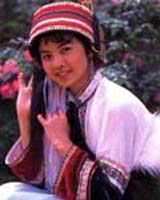 Beauty contests for various titles are now held so often and in so many different parts of the world that they are not as eye-catching as they used to be. People find that they are more about business than beauty itself, with conspicuous sponsorships. But, deep in a mountainous area of Southwest China's Sichuan Province, a beauty contest takes place every year that lives up to its name and has nothing to do with business.
Beauty contests for various titles are now held so often and in so many different parts of the world that they are not as eye-catching as they used to be. People find that they are more about business than beauty itself, with conspicuous sponsorships. But, deep in a mountainous area of Southwest China's Sichuan Province, a beauty contest takes place every year that lives up to its name and has nothing to do with business.
The Yi ethnic minority of the Liangshan Yi Prefecture, in southwest Sichuan, holds beauty contests on important holidays with no sponsorship or prizes.
The tradition dates back to the Tang Dynasty (AD 618-907).
The most spectacular one is held every year on the 25th day of the sixth month of the Lunar Calendar.
This is one day after the Torch Festival, the biggest holiday for the Yi people and equivalent to the Han people's Spring Festival.
Last summer, I was lucky enough to witness such a pageant in Butuo County in the south of the prefecture.
I arrived in the county one day before the Torch Festival, which was to be celebrated at an open-air venue in Tuojue District. The venue would also be the location of the beauty contest.
As our car passed through different villages, I saw people there busy slaughtering oxen and sheep, preparing food and drying their newly washed costumes in the sun.
The air was filled with a festive mood.
I was told that there are three things a young Yi woman must prepare for the beauty contest: a red-and-blue pleated wool skirt, a yellow parasol and a white or black shawl.
She also has to rehearse for several months with her friends before the contest to perform a traditional folk song and dance called duolehe.
Young Yi women weave and dye the cloth and make the costumes themselves because they dislike mass-produced modern fabrics and clothes. The parasols are needed to protect them from the scorching sunshine in this high-altitude region.
Our car stopped at the house of a contestant called Ermumotuluo. The family was busy folding a black cap for the girl to wear. The cap bore images of flowers, grass and birds and patterns symbolizing happiness and good fortune. Her costumes were ready and so were the silver accessories, which weigh about two or three kilograms in all.
Some of the young women had put on pleated skirts, the tall hapa cap and the white wool habo shawl. Others, afraid of being worn out by wearing the heavy costumes and accessories all day, chose to carry their dresses in a bag to the venue and then got changed while hiding in the corn fields.
As they arrived the venue, the young women found a place to sit down, opened their yellow parasols, took out their cosmetics and put on their make-up with the help of a mirror.
Ermumotuluo - the young woman I had visited the day before - showed up and got a round of applause from the mostly male audience.
In a tall black cap decorated with silver jewelry and her gorgeous pleated skirts, she stood out among the 20 or so family members and friends with her. I marveled at such a picture-postcard moment, with the backdrop of blue sky, floating white clouds and blossoming wild flowers.
The beauty contest began at noon. There were no entry requirements for contestants, no limits to the number of participants and no rules. There were now nearly 10,000 people at the venue and they were either contestants or judges.
Contestants teamed up with their family and friends. They all wore white or black shawls and held yellow parasols and colorful handkerchiefs. Each team formed a circle and started to sing and dance the duolehe.
The songs encouraged young men and women to find their partners. The melodies and swirling colorful skirts attracted many young men. They approached the contestants, flirted with the beautiful young women or recorded the songs on cassette recorders.
It is said that many young men and women meet during the contests and later get engaged.
The audience judged the faces, figures and costumes of the young women and aired their opinion.
According to 70-year-old villager Moshuo, the Yi people set certain criteria for a woman's beauty.
She should have a well-proportioned body, smooth skin, thin and petite lips, long and curved eyelashes and long, thick and dark plaits. She should also behave and speak gracefully.
The most beautiful young women in the contest have their names spread near and far.
In the days after the contest, many young men and matchmakers frequent their houses to make them attractive offers.
The contest also featured wrestling and horse racing on the sidelines. It lasted until 5 pm. By then, some young women had retreated to the woods for a rest, to grab a bite to eat or chat with friends.
They then returned to the crowds and sang and danced until it was time to go home.
(China Daily March 12, 2002)
